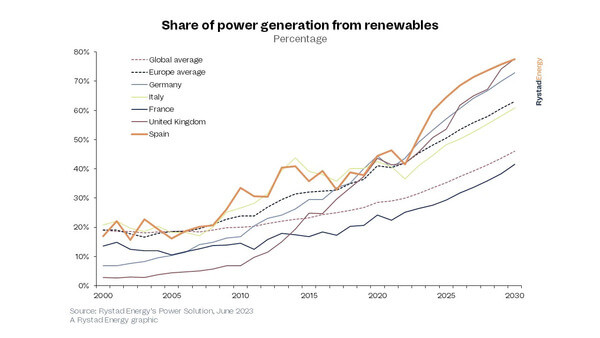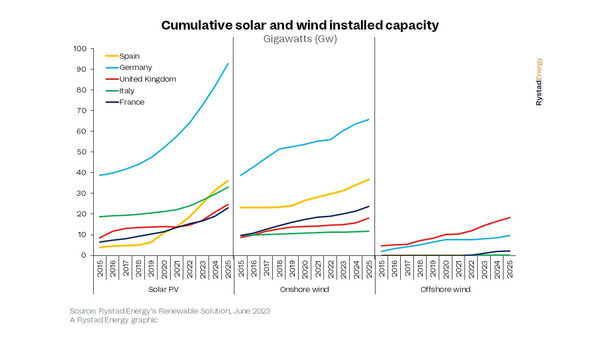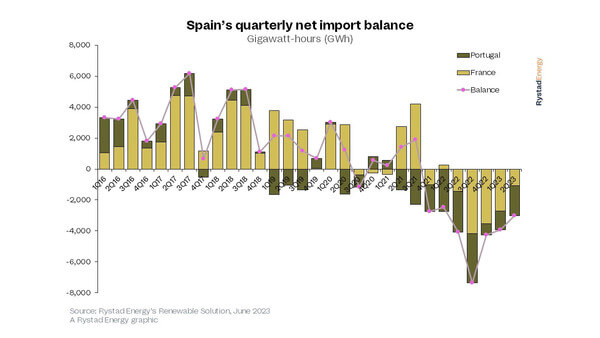News Release from Rystad Energy
Wind Industry Profile of
Spain’s renewable power generation to top 50% in 2023, surpassing European neighbors on strong wind and solar capacity
Spain will reach this significant decarbonization milestone this year, with renewable-sourced generation surpassing the 50% average in 2023, beating France, Germany, Italy and the UK to this record.
Spain has been one of the long-time leaders in the European renewables sector, making substantial investments in solar and wind capacity over the last 10 years. In particular, the country was an early adopter of onshore wind, technology that now accounts for more than 20% of Spain’s power generation. Significant solar PV investments have also ramped up capacity and related generation in recent years. Hydropower, which used to be Spain's largest source of renewable energy, accounts for approximately 10% of its total generation today.
"Spain's renewable energy achievements come as no surprise given its history of strategic investments and early adoption. Its progress should be a clear benchmark for counterparts and serve as testament to the attainability of a cleaner energy future," said Fabian Ronningen, senior renewables and power analyst, Rystad Energy.

Learn more with Rystad Energy’s Renewables and Power Solution. (Image: Rystad Energy)
Motivated by the goal to transition towards cleaner energy sources, Spain has made significant strides in reducing its reliance on fossil fuels. While natural gas currently serves as the primary source of the country’s fossil fuel-powered generation, Spain has made remarkable progress in phasing out coal-fired generation. In addition, its nuclear power plants continue to provide a stable baseload, with a planned phase-out scheduled for 2035.
In the deployment of solar and wind power capacity, Spain has outpaced its European counterparts, securing second position in onshore wind installations. Although Germany maintains dominance in solar and onshore wind, Spain's trajectory in solar and wind energy exhibits remarkable growth prospects for the coming years. These achievements can be attributed to Spain's higher installation rates of new renewable energy, which have played a vital role in increasing the share of renewables in its power generation mix.

Image: Rystad Energy
However, it has not been plain sailing, and Spain has experienced some challenges in its renewables journey. Last year saw a notable increase in fossil fuel-based generation, driven by market intervention measures and significant price differences with France. As the impact of these market intervention measures diminishes, Spain's power generation is returning to normal levels, resulting in a decline in both exports and domestic power demand in 2023. A reduction in gas-fired generation will primarily drive this decline, further boosting the role of renewables in the energy mix.
While official data from the Spanish transmission system operator confirms more than 50% renewable power generation, power exports to France could disrupt further growth in 2023. Market fundamentals have created a disparity between Spain and France, causing an increase in exports from the Iberian country to its northern neighbor. France has struggled with low nuclear power generation this year, forcing it to turn to Spain for power imports. Spain's gradual transition from a net importer to a net exporter of power not only signifies the nation’s growing prominence in the European energy landscape but also underscores its journey towards becoming a key player in the global energy market.

Image: Rystad Energy
The direct result of Spain's renewable energy success is lower consumer prices, a critical achievement after the sky-high prices of 2022. The increased share of intermittent renewables has lowered spot prices on average, and although interconnection capacity with the rest of Europe is limited, Spain’s prices have been significantly lower than France’s this year. Average power prices in France have been 34% higher than those in Spain, owing to various factors, including Spain's transition from being one of Europe's highest-priced spot markets to one of its lowest. Even when accounting for the effects of market intervention measures in 2022, the price disparity between Spain and France remains vast.
For more analysis, insights and reports, clients and non-clients can apply for access to Rystad Energy’s Free Solutions and get a taste of our data and analytics universe.
- Source:
- Rystad Energy
- Author:
- Press Office
- Link:
- www.rystadenergy.com/...
- Keywords:
- Rystad Energy, Spain, report, forecast, renewable energy, wind power, solar, neighbour, Europe, production, electricity, decarbonisation


























